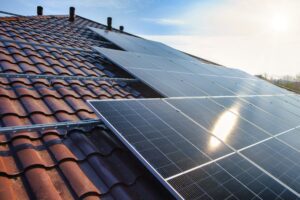Battery storage makes the most of your solar panel system. It maximises savings on electricity bills and further reduces carbon footprint. Several solar battery brands are available, which can make it difficult to decide which is best for you.
The Powerwall from Tesla is relatively new on the market so you may not have come across it before. We’ve looked in some detail at the Tesla Powerwall to save you the time and help you decide whether it’s a good fit for your home’s energy needs.
Continue reading to discover all you need to know about the Tesla Powerwall, including the different models and their pros and cons.
Tesla Powerwall Overview
The Tesla Powerwall battery reduces reliance on expensive mains electricity and ensures your home is never without power. It stores solar energy or electricity from the National Grid for later use. This gives you more energy independence. You can use the Powerwall to:
- Power your home at night, when your solar panels aren’t producing electricity.
- Provide a backup in the event of a power cut.
- Manage and control your energy consumption remotely.
Newer Powerwall models have a built-in solar inverter. This means more free energy for powering your home after the sun goes down. Furthermore, you can monitor your Powerwall system with a Tesla app and manage it to ensure optimal performance and cost savings. A Tesla Powerwall is expected to last around 10 years.
Types Of Powerwall
In February 2024 Tesla announced that Powerwall installations worldwide had hit the 600,000 milestone. Tesla launched its first Powerwall rechargeable lithium-ion battery in 2015. This had limited production and is now discontinued.
Powerwall 1 was replaced by the improved Powerwall 2. This alternating current (AC) battery system began mass production in early 2017 at Tesla’s Gigafactory in Nevada, USA. Then came the Powerwall Plus in 2021, with an integrated solar inverter. Powerwall+ was followed in late 2023 by the next-generation Powerwall 3, similar to Powerwall Plus but more compact and far more powerful.
Powerwall 2
The Powerwall 2 solar battery has more capacity and a wider range of features than its predecessor. Typical installation costs are in the range of £7,000 to £9,900 but the benefits of Powerwall 2 – such as capacity and depth of discharge – can make it a worthwhile investment.
With Powerwall 2, the sleek curves of Powerwall 1 are replaced with a more compact rectangular design. This may be less aesthetically pleasing but it’s more practical, making PW2 easier to handle and install.
Powerwall 2 has a simple on/off switch on one side of the unit, venting on either side for cooling, and a bright-green LED display. PW2 still weighs in at around 120kg, so it’s definitely not a lightweight battery. On the other hand, this Powerwall can now be installed at ground level as well as wall-mounted.
However, Powerwall 2 still relied on an external solar inverter to convert direct current (DC) electricity into alternating current. Powerwall Plus and Powerwall 3 fixed that disadvantage.
Powerwall 2 Specs
| Energy Capacity | 13.5 kWh |
| On-Grid Power | 5 kW continuous |
| Backup Power | 7 kW peak
106A LRA motor start Seamless backup transition |
| Size & Weight | 45.3″ x 29.6″ x 5.75″ (H x W x D)
251.3 lbs |
| Scalable | Up to 10 units |
| Installation | Floor or wall mounted
Indoor or outdoor -4°F to 122°F Water and dust resistance |
| Warranty | 10 years |
Powerwall Plus
The Tesla Powerwall Plus – probably the lesser-known sibling of the Powerwall family – simplifies the overall solar storage system, with more efficient energy conversion. It enhances the standard features of PW2 by incorporating a built-in grid-tied solar inverter to take direct current electricity straight from the solar panels.
The 7.6kW string inverter is combined with a 13.5kWh Powerwall 2 battery in a single unit.
Powerwall+ has a slightly higher energy capacity of 14kWh, with a power capability of 9.6kW. It also has a backup gateway to monitor and manage energy use and grid outages. Powerwall Plus may be a particularly good choice to improve overall energy efficiency for homes with limited sun exposure. Advanced energy management features and the integrated inverter ensure optimal use of the sunlight that does reach your solar panels.
The improved features of the Powerwall Plus result in installation costs of around a couple of thousand pounds more than PW2.
Powerwall Plus Specs
| Energy Capacity | 13.5 kWh |
| On-Grid Power | 7.6 kW / 5 kW continuous |
| Backup Power | 9.6 kW / 7 kW continuous
22kW / 10kW peak 118A LRA motor start Seamless backup transition |
| Inverter | Solar-to-grid efficiency 97.5%
4 solar inputs with Maximum Power Point Trackers |
| Size & Weight | 62.8″ x 29.7″ x 6.3″ (H x W x D)
343.9 lbs |
| Scalable | Up to 4 units |
| Installation | Integrated inverter and system controller
-4°F to 122°F Water and dust resistance |
| Warranty | 10 years |
Powerwall 3
Powerwall 3 is a significant upgrade on previous versions. The most crucial improvement is that PW3 is an all-in-one, hybrid battery and DC-coupled solar system including a solar inverter. Solar inverters are critical components in solar energy systems. Solar panels produce DC power from the sun, while households need AC power, as supplied by the utility grid. A solar inverter converts DC solar power to AC household power.
The new Powerwall is essentially the same type of all-in-one system as Powerwall+ but has been reconfigured with a more powerful 11.5kW inverter and higher 20kW solar capacity. Powerwall 3 also boasts six individual solar connections, two more than Powerwall Plus. These maximum power point trackers (MPPTs) convert the higher voltage direct current from solar panels to the lower voltage needed to charge a battery. This enables up to nearly 20kW of solar – 3.3kW per connection.
Tesla is also working on development of battery expansion units. Up to three optional 13.5kWh units are expected to become available for Powerwall 3, for a combined total of 54kWh.
One drawback that Powerwall 3 carries over from Powerwall 2 is that it still needs a gateway unit to enable backup power of critical loads during a power outage. Powerwall 3 installation costs start from around. £7,800.
Powerwall 3 Specs
| Energy Capacity | 13.5 kWh |
| On-Grid Power | 11.5 kW continuous |
| Backup Power | 11.5 kW continuous
185 LRA motor start Seamless backup transition |
| Inverter | Solar-to-grid efficiency 97.5%
6 solar inputs with Maximum Power Point Trackers |
| Size & Weight | 43.25″ x 24″ x 7.6″ (H x W x D)
287 lbs |
| Scalable | System expansion available anytime
40.5 kWh max addition per unit |
| Installation | Integrated inverter and system controller
-4°F to 122°F Flood and dust resistance |
| Warranty | 10 years |
About Tesla
Tesla is a driving force in the battery storage market, and development of the Powerwall is part of its mission to accelerate global transition to solar energy. The Powerwall is made by Tesla Energy Operations, a division of Tesla Inc, the US-based trillion-dollar multinational clean energy and battery electric vehicle company.
The business – part of the Elon Musk empire – is named after Nikola Tesla (1856-1943), the Serbian-American genius who revolutionised technology with his groundbreaking energy-related inventions. Tesla began life as electric car company Tesla Motors, founded in 2003 by Californian entrepreneurs Marc Tarpenning and Martin Eberhard.
Within less than a year, the controversial investor and businessman Elon Reeve Musk – said to be the richest person in the world – became the largest shareholder and later its chief executive officer. Musk also owns X Corp (formerly Twitter) and is known for his roles in space company SpaceX and OpenAI.
Final Thoughts On The Tesla Powerwall
The first-generation Tesla Powerwall took the energy storage world by surprise nearly 10 years ago. Since then, the Powerwall battery system has made a huge impact and is playing a key role in driving home energy storage into the mainstream globally.
Unlike the AC battery system of Powerwall 2, Powerwall+ integrates a solar inverter alongside energy storage, in one simple system. So does the new Powerwall 3, but with a more powerful inverter and higher output capacity.
As a leading UK solar panel and battery provider, Effective Home keeps a close eye on developments in solar systems and energy storage. We’ve done our homework on PW3 and were impressed by its high-standard technical specifications. That’s why we’ve become one of the first Tesla Powerwall certified installers in the UK and are now offering Powerwall 3 to our customers, alongside other quality systems such as Sunsynk solar batteries.
Tesla Powerwall FAQs
How many Tesla Powerwall batteries do I need?
A single Powerwall 3 battery has the storage capacity to power an entire home and provide backup protection.
Can I get paid for electricity I don’t use?
Yes, you can. Under the government-backed Smart Export Guarantee (SEG), major energy providers pay for surplus solar energy you send to the National Grid. Tariffs vary but you may be able to get 4p to 6p for each kWh of excess electricity your Tesla Powerwall system stores.
Is there VAT on the Tesla Powerwall?
Definitely not. Like all solar batteries and solar panels, value added tax on supply and installation of Tesla Powerwall systems is zero-rated until the end of March 2027, when it’s expected to revert to the original reduced rate of five percent.



